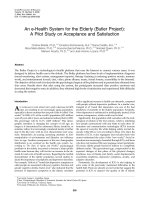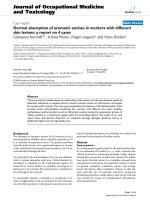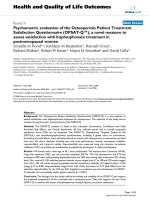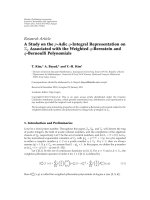A project report on employees satisfaction with supervisor at anh fashion and cosmetics co , LTD (dafc)
Bạn đang xem bản rút gọn của tài liệu. Xem và tải ngay bản đầy đủ của tài liệu tại đây (684.92 KB, 67 trang )
RESEARCH PROJECT
(BMBR5103)
A PROJECT REPORT
ON
EMPLOYEES’ SATISFACTION WITH SUPERVISOR
AT DUY ANH FASHION AND COSMETICS CO., LTD
(DAFC)
STUDENT’S FULL NAME
: TRAN ANH VU
STUDENT ID
: CGS00019907
INTAKE
: SEPTEMBER 2015
ADVISOR’S NAME & TITLE : DBA NGUYEN THE KHAI
March, 2017
ADVISOR’s ASSESSMENT
------------------------------------------------------------------------------------------------------------------------------------------------------------------------------------------------------------------------------------------------------------------------------------------------------------------------------------------------------------------------------------------------------------------------------------------------------------------------------------------------------------------------------------------------------------------------------------------------------------------------------------------------------------------------------------------------------------------------------------------------------------------------------------------------------------------------------------------------------------------------------------------------------------------------------------------------------------------------------------------------------------------------------------------------------------------------------------------------------------------------------------------------------------------------------------ADVISOR’s SIGNATURE
DBA NGUYEN THE KHAI
TRAN ANH VU – MBAOUM0915-K19C
ACKNOWLEDGMENTS
At the beginning of this report, I have to say that it is not possible to finish this
report without receiving the support and encouragement of other people. I would
like to extend my sincere towards all the personages who have helped me in this
project. Without their help, cooperation and encouragement, I would not complete
this project.
I am extremely thankful to my faculty Dr. NGUYEN THE KHAI, Ms. DO THI
THANH TRUC, Mr. SU NGOC HOANH for their valuable guidance and
assistance on completion of this project.
Thank you to Duy Anh Fashion and Cosmetics Co., Ltd. (DAFC) management and
my colleges for their useful information related to the survey.
I also special thank you to my parents and my family who has always supported me
morally as well as economically.
At last but not least gratitude goes to all of my friends who always stand by my side
and helped me to complete this project.
Once again, thank you to you all.
TRAN ANH VU
TRAN ANH VU – MBAOUM0915-K19C
TABLE OF CONTENTS
ABSTRACT ...................................................................................................... 1
CHAPTER 1 – INTRODUCTION ................................................................. 2
1. Company review ........................................................................................... 2
1.1 About DAFC ............................................................................................ 2
1.2 Vision and Mission statement .................................................................. 4
1.3 Organization Structure ............................................................................. 5
2. Research introduction .................................................................................. 9
2.1 Purpose and Objective ............................................................................. 9
2.2 The empirical setting ............................................................................. 10
2.3 Instruments............................................................................................. 10
2.4 Research scope ....................................................................................... 10
2.5 Significance of the study ....................................................................... 10
2.6 Question of the study ............................................................................. 11
2.7 Limitation of research ............................................................................ 11
CHAPTER 2 – LITERATURE REVIEW ................................................... 12
1. Work control (WC) .................................................................................... 12
2. Empowerment at work scale (EW) ........................................................... 13
3. Procedural Justice in Performance Appraisal (PJ) ................................ 14
4. Role conflict and ambiguity (RC) ............................................................. 16
5. Satisfaction with my supervisor (SS) ........................................................ 18
TRAN ANH VU – MBAOUM0915-K19C
CHAPTER 3 - RESEARCH MODEL AND HYPOTHESES.................... 19
1. Research model ........................................................................................... 19
2. Constructs ................................................................................................... 21
2.1 Key construct ......................................................................................... 21
2.2 Other construct ....................................................................................... 21
3. Research Hypotheses ................................................................................. 21
3.1 The relationship between Work control and Satisfaction with My
Supervisor .................................................................................................... 21
3.2 The relationship between Empowerment at work scale and Satisfaction
with my supervisor....................................................................................... 22
3.3 The relationship between Procedural Justice in Performance Appraisal
and Satisfaction with my supervisor ............................................................ 24
3.4 The relationship between Role conflict and ambiguity and Satisfaction
with my supervisor....................................................................................... 25
4. Instruments ................................................................................................. 26
4.1 Section one ............................................................................................. 26
4.2 Section two ............................................................................................ 26
5. Data collection progress ............................................................................. 28
CHAPTER 4 - RESULTS .............................................................................. 30
1. Reliability statistic ...................................................................................... 30
1.1 Work Control ......................................................................................... 30
TRAN ANH VU – MBAOUM0915-K19C
1.2 Empowerment at work scale .................................................................. 31
1.3 Procedural Justice in Performance Appraisal ........................................ 31
1.4 Role conflict and ambiguity................................................................... 32
1.5 Satisfaction with My Supervisor ........................................................... 32
2. Descriptive statistic .................................................................................... 33
3. Correlation statistic .................................................................................... 34
CHAPTER 5 – HYPOTHESES TESTING RESULTS .............................. 36
1. Hypothesis 1 ................................................................................................ 37
2. Hypothesis 2 ................................................................................................ 38
3. Hypothesis 3 ................................................................................................ 38
4. Hypothesis 4 ................................................................................................ 39
CHAPTER 6 - CONCLUSION AND DISCUSSION.................................. 39
REFERENCE ................................................................................................. 46
APPENDIX ..................................................................................................... 49
Appendix 1: Survey ..................................................................................... 48
Appendix 2: Presentation ............................................................................. 58
TRAN ANH VU – MBAOUM0915-K19C
ABSTRACT
This study examines the influence of some factors on the satisfaction with
supervisor of employees who are working at DAFC.
By using Business Research Methods, this research project will determine the
relationship between the Satisfaction with supervisor and Work control,
Empowerment at work scale, Procedural Justice in Performance Appraisal, Role
conflict and ambiguity. Questionnaires were sent personally to 400 managers and
employees in DAFC; there were 325 pieces returning, in which 272 completely
responses were used for the statistical analysis. The result then shall be statistically
analyzed by software SPSS.
The results can provide the Management Team some useful information about the
relationship between Work control, Empowerment at work scale, Procedural Justice
in Performance Appraisal, Role conflict and ambiguity and Satisfaction with my
supervisor. Hope DAFC uses my research to develop the relationship between
employees and their managers.
Key words in this research: Work control, Empowerment at work scale, Procedural
Justice in Performance Appraisal, Role conflict and ambiguity and Satisfaction with
my supervisor.
TRAN ANH VU – MBAOUM0915-K19C
Page 1 of 61
CHAPTER 1 – INTRODUCTION
1. Company review
1.1 About DAFC
Imex Pan Pacific Group was established in 1985 by Johnathan Hanh Nguyen. With
a total investment of more than USD 535 million, IPP is one of the companies that
have strongest financial capability. Revenue is increased by an average 20%. Total
revenue reached USD 1 billion in 2016. IPP is the owner of numerous projects in
trading fields: fast-food chains; duty-free shops at international airports in Vietnam;
exclusive distributor of famous fashion brands and cosmetics in the world.
Through more than 30 years of operation, IPP Group has achieved:
Create 22,000 job opportunities for Vietnamese labors.
Have 28 subsidiaries and 6 joint venture companies
Open nearly 40 retail stores that exclusive distribute internationally high fashion
brands: Burberry, Bvlgari, Bally, Chanel, Cartier, Versace, Salvatore Ferragamo,
Rolex, Tumi…
Open nearly 100 retail stores that exclusive distribute internationally mid-tier
fashion brands: Gap, Banana Republic, Tommy Hilfiger, Nike and Calvin Klein.
Open 80 stores of the world famous fast food restaurant chain: Burger King,
Domino's Pizza, Popeyes and Dunkin 'Donuts.
Open 120 duty-free shops and retail stores in the largest airports in Vietnam.
TRAN ANH VU – MBAOUM0915-K19C
Page 2 of 61
TRAN ANH VU – MBAOUM0915-K19C
Page 3 of 61
DAFC, a subsidiary of IPPG, was founded in 2005. DAFC is an exclusive
distributor and retailer of the famous luxury fashion & cosmetics brands in Vietnam
such as Bally, Salvatore Ferragamo, Bulgari, Burberry, Cartier, Rolex, Versace,
Versace Home, Versace Jeans, Ermenegildo Zegna, Just Cavalli, etc. We allocate at
the biggest shopping centers in HCM City and Hanoi like Diamond Plaza, Rex
Arcade, Trang Tien Plaza, Saigon Center, etc.
1.2 Vision and Mission statement
Vision
In Vietnam, DAFC will be a leading Retailer in its core businesses - Retail Fashion
through its commitment to Colleagues, Business Partners, Customers and Owners.
Mission
DAFC are committed to perform best practices at its highest standards. We will
value our internal and external customers.
Core Values
WOW delivery through service.
Focus and develop on the product offered.
Commit towards staff training & development.
Mission Statement Component:
1. Customers: middle-class to high-class group.
2. Products: luxury merchandise.
TRAN ANH VU – MBAOUM0915-K19C
Page 4 of 61
3. Markets: Vietnam.
4. Technology: all system was managed by digital devices.
5. Concern for survival, growth, and profitability: reach USD 1 billion.
6. Philosophy: help customers live fashionable.
7. Self-concept: leading in fashion trend.
8. Concern for public image: participate in charitable activities, build schools for poor
pupils, establish many funds in Vietnam.
9. Concern for employees: offer good working conditions, compensation on the basis
performance, opportunities for growth.
Contact
Company name: Duy Anh Fashion and Cosmetics Co., Ltd
Tell: 3.8257537
Fax: 3.8257540
Email:
1.3 Organization Structure
DAFC follows the functional organization structure. The company is divided into
separately units based on role, such as Brands, HR, Finance, Logistics, etc. The
functional structure offers a number of potential advantages as well as
disadvantages.
TRAN ANH VU – MBAOUM0915-K19C
Page 5 of 61
MANAGING
DIRECTOR
MANAGING
DIRECTOR
HA NOI
BRANCH
GROUP
BRAND
DIRECTOR
BRAND
MANAGER
MERCHAN
DISING
MANAGER
BUSINESS
DEVELOPMENT
DIRECTOR
MARKETING
MANAGER
FINANCE
DIRECTOR
VISUAL
MERCHANDI
SER
OPERATION
TRAN ANH VU – MBAOUM0915-K19C
HR AND
ADMIN
DIRECTOR
IT
MANAGER
HEAD OF
LOGISTIC
HEAD
OF
CRM
LEGAL
MANAGER
Page 6 of 61
The first advantage is that it offers a high level of specialization. Each unit operates
as a type of self-contained mini-company, charged with carrying out its specific
role. Employees often start their careers in an entry-level position, then build up
their knowledge and look for a change to move up within the hierarchy. After a long
time, they become experts within their functional area, and the unit and company
benefit from their expertise and experience over time. Furthermore, an employee
who is an expert in his functional area can perform tasks with a high level of speed
and efficiency, which enhances productivity. If they know their jobs well, they can
proceed with confidence and with a minimum amount of mistakes.
The first disadvantage is lack of teamwork. Employees often perform with a high
level of efficiency in their department. If a company has a project which need whole
company work together, they may have difficulty working well with other units. In
essence, each unit may act in what it perceives to be its own best interests instead of
those of the organization as a whole. Infighting may cause projects to fall behind
schedule. For example, in DAFC we often organize many sale events in a year to
clear the old season stock. Whenever we do it, we will have a meeting with the
managing director. But people in different department seem not happy to work
together. None of them want to become the leader of the private sale. They are
always afraid of taking responsibilities.
TRAN ANH VU – MBAOUM0915-K19C
Page 7 of 61
Another disadvantage of the functional organization structure is that it can pose a
challenge for top management to maintain control as the organization expansion. In
the past, we only have 4 brands, so we did not have the Group Brand Director
position. Brand manager directly reported to Managing Director. Now there are
over 30 brands, so Brand Manager reports to Group Brand Director. Group Brand
Director reports to Managing Director.
Employees are the most valuable resources of an organization. The long-term
success of any company depends heavily upon the quality of its workers and worker
loyalty. Employees’ job satisfaction may enhance their motivation, performance and
reduces absenteeism and turnover. Job satisfaction is the level of employees feel
about their work, which can affect their performance. Employee job satisfaction is
correlated with package, benefits, recognition, promotion, coworkers and
management support, working conditions, type of work, job security, leadership
style of managers, and demographic characteristics such as gender, marital status,
educational level, age, work tenure, and number of children.
Leadership behavior of managers plays an important role in employees’ job
satisfaction and commitment. It is the ability of a manager to influence, motivate,
and enable employees to contribute toward organizational success. It is the process
of influencing a group of people towards achieving organizational goals. There are
various leadership styles that managers can use to lead and direct their employees
TRAN ANH VU – MBAOUM0915-K19C
Page 8 of 61
including
autocratic,
bureaucratic,
laissez-faire,
charismatic,
democratic,
participative, transactional, and transformational leadership styles. Different
leadership styles are used for different situations. Effective leader must know when
to exhibit a particular approach.
2. Research introduction
2.1 Purpose and Objective
“People leave bosses, not companies!”
Almost every single one of us has heard this statement at some point during the
career path, in fact, sometimes we have said ourselves.
And it’s true. According to a Gallup study around 50% of employees leave their
company to get away from their bosses.
Sometimes the employees work for one company because of their bosses, not
because of the company. It can be said that the relationship between managers and
employees is very important.
The purpose of this research is to:
First: collect related information and define the level of Satisfaction with my
supervisor of employees working at DAFC.
Second: design research model and test related factors to check their influences to
the Satisfaction with my supervisor of employees working at DAFC.
TRAN ANH VU – MBAOUM0915-K19C
Page 9 of 61
Third: discuss and propose an action plan to build a strong connection between
managers and employees.
2.2 The empirical setting
Most of employees working at DAFC participated in this study.
2.3 Instruments
Questionnaires were sent personally to 400 managers and employees in DAFC. The
questionnaire package contained a cover letter, and questionnaires related to Work
control, Empowerment at work scale, Procedural Justice in Performance Appraisal,
Role conflict and ambiguity and Satisfaction with my supervisor.
2.4 Research scope
The scope of research is for the employees at DAFC, includes: Group Brand
Directors, BU Head, Managers, Subordinate and Employees; not include: General
Manager.
This survey was conducted from Feb 1st to Mar 1st 2017.
2.5 Significance of the study
This study is conducted from both managerial and non-managerial employees. The
opinion of employees in DAFC about the impact of Work control, Empowerment at
work scale, Procedural Justice in Performance Appraisal, Role conflict and
ambiguity on Satisfaction with my supervisor will be collected to see the
relationship between these factors.
TRAN ANH VU – MBAOUM0915-K19C
Page 10 of 61
Moreover, this research provides the management team knowledge to manage the
team better.
2.6 Question of the study
Some points are addressed as below:
1. How is the impact of Work control on Satisfaction with my supervisor?
2. How is the impact of Empowerment at work scale on Satisfaction with my
supervisor?
3. How is the impact of Procedural Justice in Performance Appraisal on Satisfaction
with my supervisor?
4. How is the impact of Role conflict and ambiguity on Satisfaction with my
supervisor?
2.7 Limitation of research
Although this research was carefully prepared, I am still aware of its limitations and
shortcomings:
1. Data is collect from fashion and retail business. The result may not be applied for
other fields.
2. The research was conducted for four weeks. It is not enough for the researcher to
observe all of the employees’ opinion at DAFC. It would be better if it was done in
a longer time.
TRAN ANH VU – MBAOUM0915-K19C
Page 11 of 61
3. If data can be collected from many retail companies, the results may more
persuaded.
CHAPTER 2 – LITERATURE REVIEW
Constructs Definition
This chapter presents the basic and relevant theories of the constructs are used,
including:
1. Work control (WC)
2. Empowerment at work scale (EW)
3. Procedural Justice in Performance Appraisal (PJ)
4. Role conflict and ambiguity (RC)
5. Satisfaction with my supervisor (SS)
1. Work control (WC)
Work control was developed by Dwyer and Ganster (1991), describes the extent to
which workers perceive they have control over numerous aspects of the work
environment. These aspects include control over the variety of tasks performed, the
order of task performance, the pace of tasks, task scheduling task procedures, and
arrangement of the physical layout/environment.
Work control refers to the extent that employee can exert influence over task and
conduct during a normal working day.
TRAN ANH VU – MBAOUM0915-K19C
Page 12 of 61
Control over aspects of a job correlated positively with sick days taken, ji workload,
and work satisfaction. In multivariate analysis, control modérait the relationship of
workload with work satisfaction (Dwyer & Ganster1991).
2. Empowerment at work scale (EW)
This measure, developed by Spreitzer (1995), describes the extent to which
employees believe they are empowered in their jobs. Empowerment has been
defined as the intrinsic motivation resulting from four cognitions reflecting an
individual’s orientation to his or her work role. The four cognitions are meaning,
competence, self-determination, and impact (Spreitzer, 1995). Meaning involves a
fit between the requirements of a work role and a person’s beliefs, values, and
behaviors. Competence refers to self-efficacy specific to work, a belief in one’s
capability to perform work activities with skill, analogous to personal mastery. Selfdetermination reflects autonomy over the initiation and continuation of work
processes and making decisions about work methods, pace, and effort. Impact is the
degree to which a person can influence strategic, administrative, or operating
outcomes at work.
A factor analysis showed that the 12 items all loaded on four factors corresponding
to the dimensions of meaning, competence, self-determination, and impact (Gagne
et al., 1997). In Spreitzer (1995), confirmatory factor analysis showed the items
loaded on the appropriate subscales and found evidence for an underlying secondTRAN ANH VU – MBAOUM0915-K19C
Page 13 of 61
order factor of overall empowerment. In Kraimer, Seibert, and Liden (1999),
confirmatory factor analysis in two samples collected at different points in time
showed that the four empowerment dimensions were distinct from one another. The
meaning, competence, self-determination, and impact dimensions all correlated
positively with job satisfaction (Spreitzer et al., 1997). In addition, all of the
dimensions except meaning correlated negatively with strain and positively with
self-reported job effectiveness. Additional analysis in Spreitzer (1995) showed that
self-esteem and information about an organization’s mission were both antecedents
of empowerment. In addition, both perceived managerial effectiveness and
innovative behaviors were consequences of empowerment. Using structural
equation models, Kraimer et al. (1999) found that job meaningfulness was related
positively with meaning, job autonomy was related positively with selfdetermination, and task feedback related positively with competence and impact.
Both meaning and competence were related positively with career intentions and
impact was related directly with organizational commitment.
3. Procedural Justice in Performance Appraisal (PJ)
Performance appraisal is an annual review of an employee’s overall contributions to
the company by his/her manager. Performance appraisals, also called annual
reviews, evaluate an employee’s skills, achievements and growth, or lack thereof.
Performance appraisals also help employees and their managers create a plan for
TRAN ANH VU – MBAOUM0915-K19C
Page 14 of 61
employee development through additional training and increased responsibilities, as
well as to identify shortcomings the employee could work to resolve.
Companies use performance appraisals to give employees big-picture feedback on
their work and to justify pay increases and bonuses, as well as termination decisions
Procedural Justice in Performance Appraisal, developed by Dulebohn and Ferris
(1999), uses six items to assess the fairness of the procedures and process used for
performance evaluation. The measure focuses on the extent to which employees
believe their supervisor used important and accurate information in appraising
employee performance
Procedural justice evaluations correlated positively with decision control, quality of
supervisor relationship, voice opportunity, employee performance ratings, and
supervisor-influence tactics such as praising employees for accomplishments.
Procedural justice evaluations correlated negatively with job-focused influence
tactics, such as working harder (Dulebohn & Ferris, 1999). Confirmatory factor
analysis showed that the six items loaded on the procedural justice factor as
anticipated and that procedural justice evaluations were empirically distinct from
assessments of the quality of the employee’s supervisory relationship, opportunities
for employees to question the basis for performance ratings (employee voice), and
degree of control over performance rating decisions (Dulebohn & Ferris, 1999).
TRAN ANH VU – MBAOUM0915-K19C
Page 15 of 61
4. Role conflict and ambiguity (RC)
Role conflict is incompatibility of different tasks in the same role, often arising
when the priorities of one system come in conflict with the priorities of the other
systems. An employee's list of tasks may find one task at odds with another task.
Role conflicts usually come from incompatible demands made by people who have
a stake in the role, incompatible pressures arising from the employee’s membership
in multiple groups, opposing pressures from different role senders, and a conflict
between personal values and prescribed role behavior. For instance, general
managers of joint ventures usually experience role conflict because of two or more
bosses with two sets of expectations.
Role ambiguity is lack of clarity on one’s job profile. The employee remains
confused about his or her role or tasks, caused by lack of required information, lack
of communication of available information, or receipt of contradictory messages
regarding the role. The CEOs of joint ventures very often experience role ambiguity
as they lack sufficient information regarding the specific expectations of the
different policy-makers in each parent firm, different expectations of the different
employee groups in the ventures, and divergent expectations from the vastly
different stakeholders.
Role conflict and ambiguity, developed by Rizzo, House, and Lirtzman (1970), was
one of the first measures of role ambiguity and role conflict. A lack of necessary
TRAN ANH VU – MBAOUM0915-K19C
Page 16 of 61
information regarding role expectation for a given organizational position has been
defined as role ambiguity. Role conflict was defined as a condition of when
employees have incompatible roles defined by supervisors or other members of an
organization. This measure includes intrarole, interrole, and intersender conflict, as
well as ambiguity due to lack of role predictability, role clarity, and role certainty
(Bedeian, Mossholder, Kemery, & Armenakis, 1990).
Though the role conflict and role ambiguity measures have been used extensively,
some scholars have raised concerns about the content validity, susceptibility to
wording biases and factor structure of this measure (King & King, 1990; Smith,
Tisak, & Schmieder, 1993). Netemeyer and colleagues (1995) evaluated alternative
structural models and showed that role conflict and role ambiguity is distinct
constructs (Netemeyer et al., 1995; Netemeyer, Johnston, & Burton, 1990). Harris
and Bladen (1994) also found that role conflict and ambiguity were empirically
distinct from role overload, job satisfaction, and job tension. Smith et al. (1993) also
found that role conflict and ambiguity were empirically distinct in three samples.
Role conflict had direct effects on job tension and job satisfaction. Role ambiguity
did not directly affect job tension or satisfaction. Neither role conflict nor role
ambiguity directly affected propensity to leave (Netemeyer et al., 1990). In Fried
(1998), both role conflict and ambiguity correlated negatively with job
performance. Williams, Podsakoff, and Huber (1992) found that the role conflict
TRAN ANH VU – MBAOUM0915-K19C
Page 17 of 61
measure distinguished between different groups of university administrators
experiencing distinct levels of role stress.
5. Satisfaction with my supervisor (SS)
The immediate supervisor plays a pivotal role. He or she connects an employee to
senior management and vice versa, becoming the primary conduit for the flow of
information within an organization. Top down, management imparts its goals and
values through the supervisor who can best explain to individuals what these mean
and how they may affect employees. Bottom up, the immediate supervisor ensures
that employees’ voices are heard, listens to their concerns and responds to them, and
passes that feedback to senior management. What managers do, how they behave,
what they say and importantly how they say it affects employees’ attitudes about
their jobs and the organization as a whole. Employees who are unhappy and
dissatisfied with their immediate supervisors are less likely to identify with the
organization’s vision and more likely to be absent or to resign. Employees who are
engaged take pride in their work, support organizational goals and are less willing
to change jobs for a minor increase in salary.
This measure, developed by Scarpello and Vandenberg (1987), describes an
employee’s satisfaction with his or her immediate supervisor. The measure was
developed over a 3-year period using samples of more than 2,000 employees from
TRAN ANH VU – MBAOUM0915-K19C
Page 18 of 61
seven manufacturing firms and tested with more than 1,000 employees in the
insurance industry.
Although factor analysis of the 18 items making up the subscale found that the
items loaded on two factors, the factors were highly correlated (mean r across eight
samples = .60). The items loading on the second factor also loaded on the first
factor, suggesting the existence of a single underlying construct, rather than
independent dimensions (Jones et al., 1999; Scarpello & Vandenberg, 1987).
CHAPTER 3 - RESEARCH MODEL AND HYPOTHESES
1. Research model
The primary goal of this study is to investigate the relationships between Work
control, Empowerment at work scale, Procedural Justice in Performance Appraisal,
Role conflict and ambiguity on Satisfaction with my supervisor. The methodology
specifically described the research model, the research instrument, the research
hypothesis, data collection process, and the procedure for the data analysis.
H1(+): There is a positive relationship between Work control and Satisfaction with
My Supervisor.
H2(+): There is a positive relationship between Empowerment at work scale and
Satisfaction with my supervisor.
TRAN ANH VU – MBAOUM0915-K19C
Page 19 of 61









